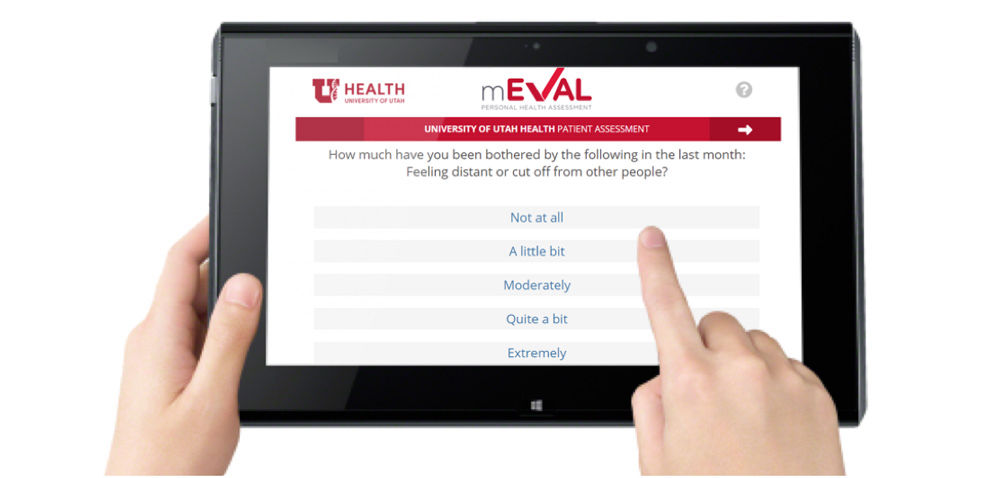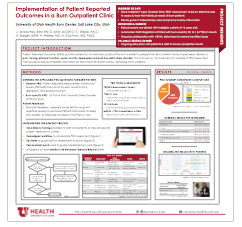Poster Download
niversity of Utah Health’s Outpatient Burn Clinic completed nearly 4,400 patient visits during fiscal year 2017. The Outpatient Burn Clinic provides care to pediatric and adult patients with burn-related wounds, along with patients who have wounds from skin infections, chronic or non-healing wounds, and wounds sustained from frostbite, Necrotizing Soft Tissue Infection (NSTI), and Toxic Epidermal Necrolysis (TEN).
The Outpatient Burn Clinic recently implemented a Patient Reported Outcomes (PROs) assessment to provide burn-related information that could improve real-time intervention. This PRO assessment quantifies symptoms, functions, and quality of life from a patient’s perspective.
Improvement starts with collaboration and feedback
We began this project by collaborating with our interdisciplinary team to identify which Patient Reported Outcomes Measurement Information System (PROMIS) instruments we wanted to use. In addition to standard assessments of general health, pain, physical function, social activity, and depression, we also wanted to assess itching and post-traumatic stress disorder (PTSD), two particularly pressing needs for burn patients.
Initially, we included sleep and anxiety instruments, but we received patient feedback that the assessment was too long. Since questions about sleep and anxiety are included in the PTSD tool, we removed them from the assessment. We implemented mEval by providing education and training through the use of scripts to help patients and staff understand the benefit of implementing patient reported outcomes.
Design workflows to minimize day-to-day impact
We email the assessment to the patient prior to their scheduled clinic visit, or provide it (through the use of a tablet) at check-in. The results are available in Epic once the assessment has been completed. These results can then be discussed with the patient during their visit to guide the plan of care.
Each assessment instrument has a reporting threshold, and we created a provider tip sheet to serve as a guide for interpreting the results. Our interdisciplinary team collaborated to decide what interval would be used for each instrument. A patient in optimal health will have a high physical function score, high social activity score, and low scores for both depression and PTSD.
Share the results—and work to strengthen the data
Since implementation in October 2016, 704 assessments have been completed for a 36% completion rate. Next, we want to identify missed opportunities—the mEval portal not showing next-day or same-day appointments, for instance—so we can increase our completion rate. Ongoing conversations with our staff about the importance and value of obtaining the assessment helps them understand that the additional steps are indeed worth the effort.
Below are results of specific instruments:
- Pain scores are close to the reporting threshold; given our patients’ circumstances, we are pleased that patient pain is being managed so well. We trend the individual 5D Itch scores and look for ways to help control this difficult issue.
- From a social perspective, our patients seem to be doing fairly well.
- The physical function scores are about where we expect.
- The mean depression results fall below the reporting threshold for a social worker referral.
- Although PTSD is a concern, the mean results are also below the reporting threshold for a social worker referral.
We have the ability to trend patient scores over time and adjust the patient’s plan of care accordingly. Our social worker and therapy staff receive daily reports with the scores for depression, PTSD, and physical function. Since implementation, we have made 34 social worker referrals for depression and 172 social worker referrals for PTSD.
Acknowledging the limitations
The integration of results into our EMR is limited, particularly with 5D Itch and the PTSD tool. In order to view specific results for each instrument, providers have to exit the EMR and log in to the mEVAL portal, which can be difficult to navigate.
It has also been challenging to obtain ongoing results for each instrument. The reports (both completion and refusal) include patients who are under 16 years old and therefore not eligible to be given the assessment. Also, accurate results need to be calculated separately from the automated report. Ongoing conversations have helped the mEVAL data team work through these issues, and we are starting to see signs of improvement.
Cultivating continuous improvement
We continue to provide ongoing education to staff and patients to improve completion rates. While repeated education can seem monotonous, it is necessary to sustain compliance and obtain results. Our hope in the future is to have Patient Reported Outcomes assessments available for our pediatric patients. We have begun to use Patient Reported Outcomes with our burn telemedicine patients, as well, supplementing the care we provide these patients remotely.
In addition, we are looking in to LIBRE, the Life Impact Burn Recovery Evaluation. This computer adaptive test is specific to people with burn injuries, assessing community participation and social impact among survivors. We hope in the future to incorporate LIBRE into mEVAL.
Since implementation, Patient Reported Outcomes have served as an effective way to assess and treat the individual needs of burn patients. The results guide interdisciplinary care and promote early intervention. As we continue to improve our completion rates, we will reach additional patients and support them in more effective and efficient ways as they transition from being a patient with an injury to being a true survivor.
Abstract: L McMurtrey, D Knitz, C Webb, K Barger, A Cochran, H Weeks; 254 Implementation of Patient Reported Outcomes in a Burn Outpatient Clinic, Journal of Burn Care & Research, Volume 39, Issue suppl_1, 9 April 2018, Pages S94, https://doi.org/10.1093/jbcr/iry006.176
Evidence Based Practice “Best of the Posters” Honoree
Of the 46 projects submitted for consideration at the April 2018 Evidence Based Practice Poster Fair, this project was one of three selected for presentation at the “Best of the Posters Session.” We applaud these efforts to share and spread best practices in delivering high value health care within our community and beyond. Learn more here.
Lisa McMurtrey
Value Week is a unique collaborative event that brings together U of U Health’s improvement community to recognize the important and impactful work conducted throughout our organization.
Finding evidence to change the status quo isn’t easy; thinking about evidence in terms of how it persuades—whether subjective or objective—can make it easier. Plastic surgery resident Dino Maglić and his colleagues followed their guts and saved money by improving the laceration trays used to treat patients in the emergency department.
Evidence-based practice (EBP) integrates clinical expertise with the best available evidence to drive innovation and improvement. Sue Childress, director of nursing at Huntsman Cancer Institute, champions the process in advance of the 5th Annual Evidence Based Practice Council Poster Fair.

